The Anti-Creasing Agent Market is estimated to be valued at USD 1.3 billion in 2025 and is projected to reach USD 2.1 billion by 2035, registering a compound annual growth rate (CAGR) of 5.0% over the forecast period.
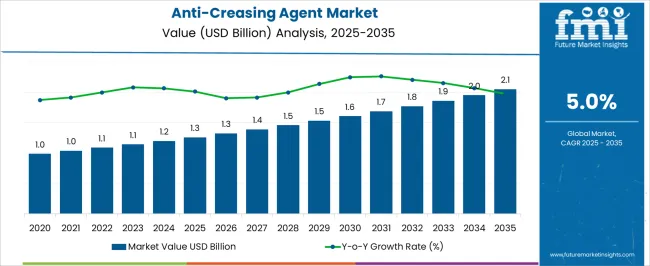
| Metric | Value |
|---|---|
| Anti-Creasing Agent Market Estimated Value in (2025 E) | USD 1.3 billion |
| Anti-Creasing Agent Market Forecast Value in (2035 F) | USD 2.1 billion |
| Forecast CAGR (2025 to 2035) | 5.0% |
The Anti-Creasing Agent market is witnessing steady growth, driven by the increasing demand for wrinkle-free and high-quality textiles across apparel, home textiles, and industrial fabrics. Rising consumer preference for easy-care and durable clothing is creating a strong adoption base for anti-creasing solutions. Technological advancements in chemical formulations, including cross linking agents and dye-bath lubricants, are enhancing fabric performance, ensuring durability, and improving aesthetic qualities.
Growing emphasis on sustainable and low-formaldehyde formulations is shaping product development, particularly for environmentally conscious markets. Manufacturers are increasingly integrating anti-creasing agents into textile finishing processes to improve productivity, reduce production costs, and meet strict quality standards.
The expanding apparel industry in emerging economies, coupled with increased automation in textile manufacturing, is further fueling demand As textile producers and brands focus on delivering high-performance fabrics while complying with environmental regulations, the market for anti-creasing agents is poised for sustained growth, supported by innovations in chemical agents, processing methods, and multifunctional finishing technologies.
The anti-creasing agent market is segmented by type, cross linking chemical agent, and geographic regions. By type, anti-creasing agent market is divided into Dye-Bath Lubricant/Anti-Creasing Agent and Wet Processing Lubricant/Anti-Creasing Agent. In terms of cross linking chemical agent, anti-creasing agent market is classified into Di Methylol Di Hydroxy Ethylene Urea (DMDHEU), Di Methylol Urea (DMU), Di Methylol Ethylene Urea (DMEU), Di Methylol Propylene Urea (DMPU), and Tri Methylol Melamine (TMM). Regionally, the anti-creasing agent industry is classified into North America, Latin America, Western Europe, Eastern Europe, Balkan & Baltic Countries, Russia & Belarus, Central Asia, East Asia, South Asia & Pacific, and the Middle East & Africa.
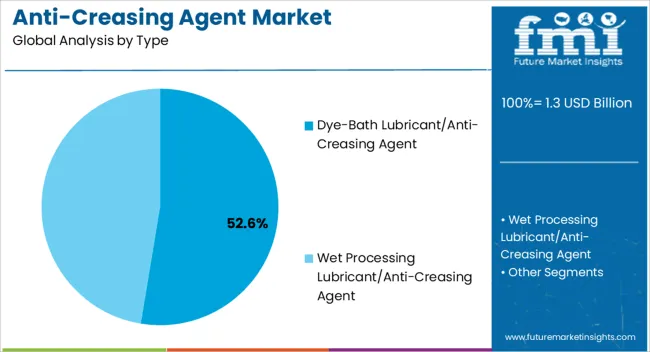
The dye-bath lubricant/anti-creasing agent type segment is projected to hold 52.6% of the market revenue in 2025, making it the leading type. Its growth is being driven by the ability to combine lubrication and anti-creasing properties, which enhances textile process efficiency and fabric quality. These agents improve fiber mobility during dyeing and finishing, reducing yarn breakage and fabric defects, while maintaining smooth, crease-free textures.
Integration with automated textile processing systems further strengthens adoption, as operational efficiency and product consistency are enhanced. The ability to optimize dye absorption and minimize chemical consumption improves cost-effectiveness for manufacturers. Increasing demand from apparel and home textile sectors for wrinkle-resistant and high-quality fabrics is further driving adoption.
Advances in chemical formulations, compatibility with various fiber types, and environmentally compliant properties reinforce the segment’s market leadership As manufacturers continue to prioritize fabric quality and processing efficiency, dye-bath lubricant/anti-creasing agents are expected to remain the dominant type in the market.
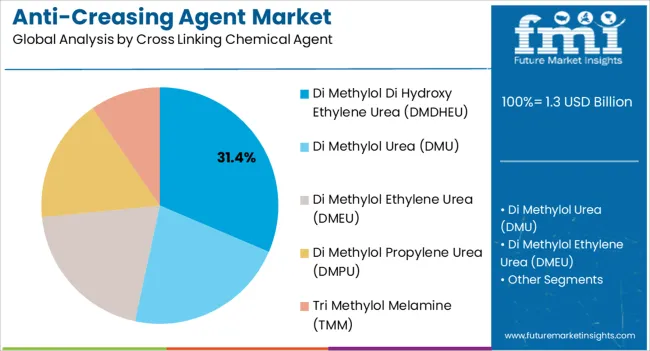
The Di Methylol Di Hydroxy Ethylene Urea (DMDHEU) cross linking chemical agent segment is anticipated to account for 31.4% of the market revenue in 2025, establishing it as the leading cross linking chemical. Its growth is being driven by the ability to form durable bonds between cellulose fibers, enhancing wrinkle resistance, fabric strength, and dimensional stability. DMDHEU offers reliable performance across cotton, blended fabrics, and other natural fibers, making it widely preferred by textile manufacturers.
The chemical agent also improves resistance to shrinkage, abrasion, and repeated washing, ensuring high-quality textile products. Innovations in low-formaldehyde and environmentally friendly DMDHEU formulations are increasing adoption in regions with strict regulatory frameworks.
Efficiency in application, compatibility with modern finishing processes, and cost-effectiveness have reinforced its market leadership As the demand for high-performance, wrinkle-resistant fabrics continues to grow in apparel and home textiles, DMDHEU is expected to maintain a significant share, driven by its proven functionality, versatility, and ability to meet evolving quality and compliance standards.
The anti-creasing agent market is one of the most important chemical markets for fabric finishing in the textile industry. Presently, it is a standard practice to use natural or synthetic resins to impart crease resistance in finished textiles; this enriches the look and performance as per end use requirement.
In recent times, rapid growth in urbanization has led to modernization of the textile industry. Thus, it is forecasted that the anti-creasing market will witness sturdy growth in the forecast period.
Several new techniques have been implemented to enhance the performance of anti-creasing agents in crease-free fabrics, such as to improve dimensional stability and produce embossed effects. Resin finishing is one such significant process employed for the improvement of dry and wet crease recovery and to retain sharp creases in fabric.
Some key types of resin finishing treatments, applied on fabric for crease-free finishing are: wash and wear finishing, anti-crease finishing and durable press treatment. Also, the various types of agents used are: soda-ash, soap, acidic/alkaline catalyst and softener, along with the thermoplastic resins and solution containing thermosetting resins.
Thus, the use of resins in the textile industry is expected to boost the anti-creasing agent market over the forecast period.
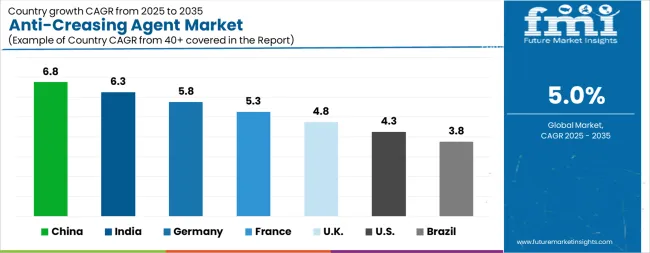
| Country | CAGR |
|---|---|
| China | 6.8% |
| India | 6.3% |
| Germany | 5.8% |
| France | 5.3% |
| UK | 4.8% |
| USA | 4.3% |
| Brazil | 3.8% |
The Anti-Creasing Agent Market is expected to register a CAGR of 5.0% during the forecast period, exhibiting varied country level momentum. China leads with the highest CAGR of 6.8%, followed by India at 6.3%. Developed markets such as Germany, France, and the UK continue to expand steadily, while the USA is likely to grow at consistent rates. Brazil posts the lowest CAGR at 3.8%, yet still underscores a broadly positive trajectory for the global Anti-Creasing Agent Market. In 2024, Germany held a dominant revenue in the Western Europe market and is expected to grow with a CAGR of 5.8%. The USA Anti-Creasing Agent Market is estimated to be valued at USD 463.9 million in 2025 and is anticipated to reach a valuation of USD 703.4 million by 2035. Sales are projected to rise at a CAGR of 4.3% over the forecast period between 2025 and 2035. While Japan and South Korea markets are estimated to be valued at USD 68.2 million and USD 41.4 million respectively in 2025.
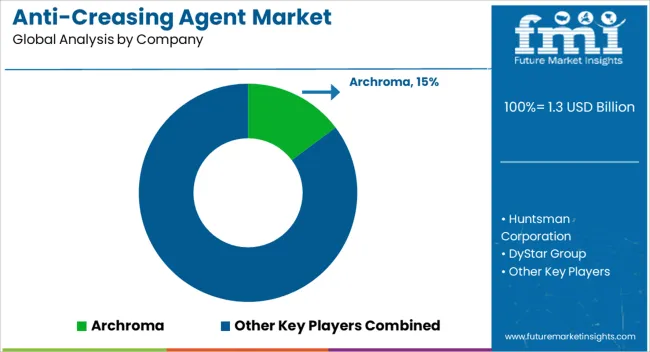
| Item | Value |
|---|---|
| Quantitative Units | USD 1.3 Billion |
| Type | Dye-Bath Lubricant/Anti-Creasing Agent and Wet Processing Lubricant/Anti-Creasing Agent |
| Cross Linking Chemical Agent | Di Methylol Di Hydroxy Ethylene Urea (DMDHEU), Di Methylol Urea (DMU), Di Methylol Ethylene Urea (DMEU), Di Methylol Propylene Urea (DMPU), and Tri Methylol Melamine (TMM) |
| Regions Covered | North America, Europe, Asia-Pacific, Latin America, Middle East & Africa |
| Country Covered | United States, Canada, Germany, France, United Kingdom, China, Japan, India, Brazil, South Africa |
| Key Companies Profiled | Archroma, Huntsman Corporation, DyStar Group, Kemin Industries, Inc., Croda International Plc, The Dow Chemical Company, BASF SE, Solvay S.A., Wacker Chemie AG, Evonik Industries AG, and Clariant AG |
The global anti-creasing agent market is estimated to be valued at USD 1.3 billion in 2025.
The market size for the anti-creasing agent market is projected to reach USD 2.1 billion by 2035.
The anti-creasing agent market is expected to grow at a 5.0% CAGR between 2025 and 2035.
The key product types in anti-creasing agent market are dye-bath lubricant/anti-creasing agent and wet processing lubricant/anti-creasing agent.
In terms of cross linking chemical agent, di methylol di hydroxy ethylene urea (dmdheu) segment to command 31.4% share in the anti-creasing agent market in 2025.






Full Research Suite comprises of:
Market outlook & trends analysis
Interviews & case studies
Strategic recommendations
Vendor profiles & capabilities analysis
5-year forecasts
8 regions and 60+ country-level data splits
Market segment data splits
12 months of continuous data updates
DELIVERED AS:
PDF EXCEL ONLINE
AI-Driven Agent-Based Modeling – Predictive Insights & Analysis
Reagent Bottle Market Growth & Industry Forecast 2025 to 2035
Reagent Filling Systems Market Analysis – Growth & Forecast 2024-2034
Fixing Agent Market Size and Share Forecast Outlook 2025 to 2035
Wetting Agent Market Size and Share Forecast Outlook 2025 to 2035
Matting Agents Market Size and Share Forecast Outlook 2025 to 2035
Healing Agents Market (Skin Repair & Soothing Actives) Market Size and Share Forecast Outlook 2025 to 2035
Foaming Agents Market Size and Share Forecast Outlook 2025 to 2035
Firming Agents Botox-Like Market Size and Share Forecast Outlook 2025 to 2035
Sealing Agent for Gold Market Size and Share Forecast Outlook 2025 to 2035
Heating Agents Market Size and Share Forecast Outlook 2025 to 2035
Cooling Agents Market Size and Share Forecast Outlook 2025 to 2035
Firming Agents Market Growth – Product Innovations & Applications from 2025 to 2035
Release Agent Market – Trends & Forecast 2025 to 2035
Gelling Agent Market Insights – Texture & Food Innovation 2025 to 2035
Raising Agents Market Trends – Growth & Industry Forecast 2024 to 2034
Weighing Agents Market Size and Share Forecast Outlook 2025 to 2035
Draining Agents Market Size and Share Forecast Outlook 2025 to 2035
Flatting Agents Market Size and Share Forecast Outlook 2025 to 2035
Proptech Agent Tool Market Trends - Growth & Forecast 2025 to 2035

Thank you!
You will receive an email from our Business Development Manager. Please be sure to check your SPAM/JUNK folder too.
Chat With
MaRIA